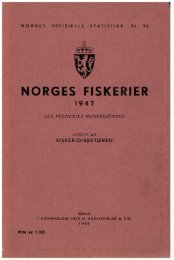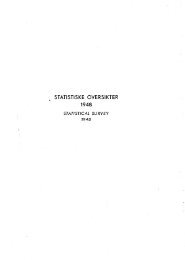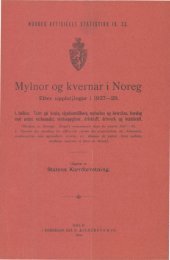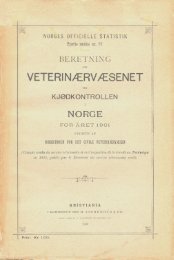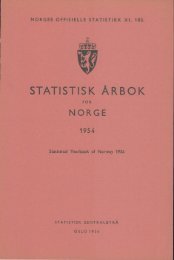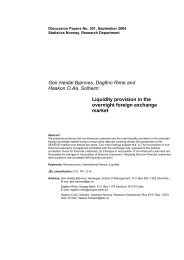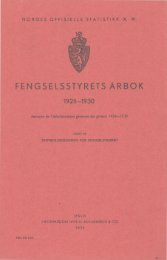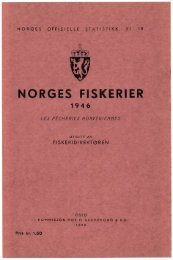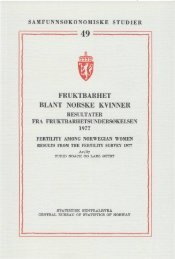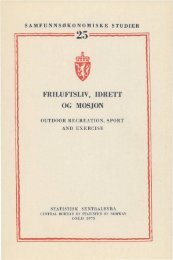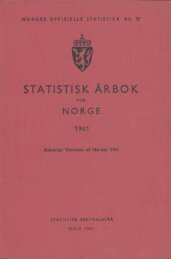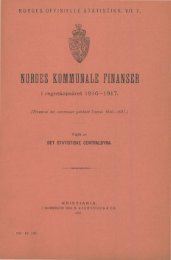Byggearealstatistikk 2004 Statistikk over eksisterende ...
Byggearealstatistikk 2004 Statistikk over eksisterende ...
Byggearealstatistikk 2004 Statistikk over eksisterende ...
Create successful ePaper yourself
Turn your PDF publications into a flip-book with our unique Google optimized e-Paper software.
<strong>Byggearealstatistikk</strong> og <strong>Statistikk</strong> <strong>over</strong> <strong>eksisterende</strong> bygningsmasse Norges offisielle statistikk<br />
3.2. Statistics production<br />
3.2.1. Population<br />
The statistics include all main buildings (no extensions)<br />
larger than 15 m 2 which have been started or<br />
completed and have not been reported demolished,<br />
burned or eliminated some other way. The observation<br />
unit is building.<br />
3.2.2. Data sources<br />
The statistics on the existing building stocks are based<br />
on data from the Ground Property, Address and Building<br />
Register (GAB). The owner of the register is the<br />
Ministry of Environment, with the Norwegian Mapping<br />
Authority professionally responsible. This register contains<br />
all buildings greater than 15 m 2 in Norway subsequent<br />
to the completion of the MABYGG project in<br />
1995.<br />
The collection of the building statistics are founded in<br />
The Statistics Act, Section 3-2 (Administrative registers).<br />
3.2.3. Sampling<br />
Complete census<br />
3.2.4. Collection of data<br />
Excel files received from the Norwegian Mapping Authority,<br />
based on transcripts from the GAB.<br />
3.2.5. Control and revision<br />
The number of buildings broken down by county and<br />
main groups of building types is compared with the<br />
year before. In the event of major changes from the<br />
year before the Norwegian Mapping Authority is contacted<br />
for explanation.<br />
3.2.6. Estimation<br />
Totals are calculated by summation.<br />
3.2.7. Confidentiality<br />
Not relevant.<br />
3.3. Concepts, variables and<br />
classifications<br />
3.3.1. Definitions of the main concepts and<br />
variables<br />
Building. As a main rule, freestanding building units<br />
are to be given a unique building number. Combined<br />
units can be assigned individual building numbers<br />
when the building parts can be torn down independent<br />
of each other.<br />
Row houses in which each dwelling unit lies on the<br />
ground are assigned one building number for each<br />
dwelling. Vertically divided semi-detached houses in<br />
which the housing units are equal shall be given one<br />
20<br />
building number for each unit. On the other hand,<br />
horizontally divided semi-detached homes, four-unit<br />
houses and larger residential buildings in which the<br />
housing units lie on top of each other are assigned one<br />
building number for the entire building.<br />
3.3.2. Standard classifications<br />
Type of building is established according to function.<br />
Combined buildings, for instance combined dwelling<br />
and business buildings, are grouped by the function<br />
that occupies the main part of the utility floor space.<br />
For an <strong>over</strong>view of types of buildings, see appendix B.<br />
3.4. Sources of error and uncertainty<br />
3.4.1. Measurement and processing errors<br />
There is a possibility that the municipalities make mistakes<br />
in registering data in the GAB register. The municipalities<br />
that do not put building cases online in the<br />
GAB register fill out a form that is sent to the county<br />
mapping office. In some cases the forms are filled in<br />
incorrectly. There are also some municipalities that for<br />
various reasons do not always follow the current registration<br />
rules for the GAB register. Buildings may be<br />
incorrectly classified, i.e. that a building has been assigned<br />
a different type of building in the register than<br />
it should have. The statistics can also include buildings<br />
that are torn down, burnt down or otherwise nonexisting,<br />
if not reported to the municipality.<br />
3.4.2. Non-response errors<br />
Full census.<br />
3.4.3. Sampling errors<br />
Full census.<br />
3.5. Comparability and coherence<br />
3.5.1. Comparability <strong>over</strong> time and space<br />
More municipalities are cleaning up their registers. As<br />
a result, buildings that were not classified the previous<br />
year may have been assigned their correct building<br />
type the year after. A number of buildings that were<br />
incorrectly classified the previous year may have been<br />
assigned the correct building type code the next year.<br />
The number of registered buildings in the municipalities<br />
may also change from year to year because of the<br />
clean up.<br />
3.6. Availability<br />
3.6.1. Publications and other links<br />
The statistics are published every year on Statistics<br />
Norway's website:<br />
http://www.ssb.no/bygningsmasse_en/



